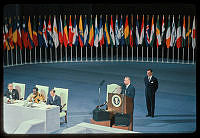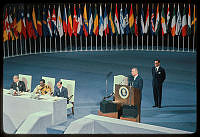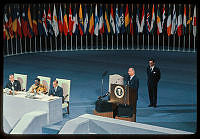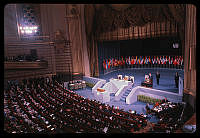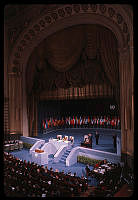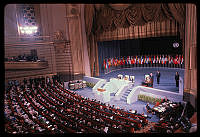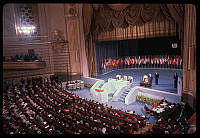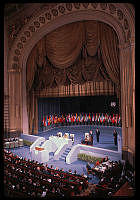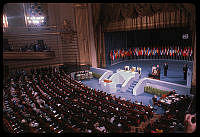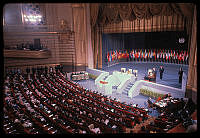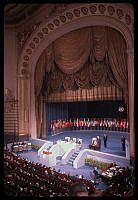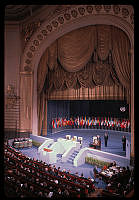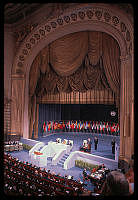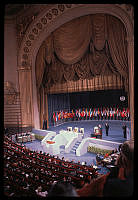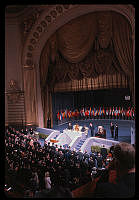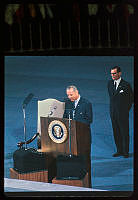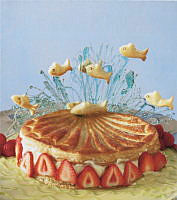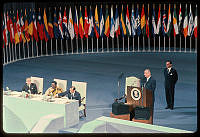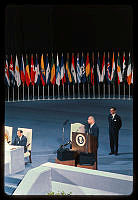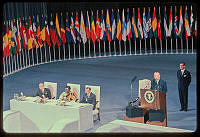Rubenstein Center Scholarship
Keeping Cool in the White House
During the 19th century Washington’s infamous summer heat and humidity presented challenges to presidents and their families. In that pre-air conditioning era, most chose to leave Washington in summer for fresher places – sometimes estates in Virginia, farms in Massachusetts, seaside or fishing retreats in New England, or on the New Jersey shore or Chesapeake Bay.
At times during the hot summer months, first families in the 19th century escaped to the higher and cooler elevation of the hills around Washington. The Lincolns enjoyed spending summers at the cottage at the Soldiers’ Home, and the Clevelands had “Red Top,” their house in the city’s sparsely settled northwest suburbs.

Awnings helped keep the White House cool before the installation of central air conditioning during the Truman renovation (1948-1952).
Air conditioning of a sort first came to the White House through tragedy. In an effort to cool the stifling sickroom of mortally wounded President James A. Garfield, U.S. Navy engineers prepared an improvised air conditioner in the summer of 1881. An electric blower forced air through a box with thin cotton screens that were kept wet with ice and ice water. Pumped through a duct into Garfield’s bedroom, the device pushed the temperature down to 80 degrees and lowered the humidity.1

After President James A. Garfield was shot on July 2, 1881, he lived for 80 days while engineers tried to cool his sickroom and doctors tried to save his life.
Kiplinger Washington Collection, Historical Society of Washington, D.C.President William Howard Taft also attempted to install a type of air conditioning in the expanded West Wing in 1909. The experimental system consisted of electric fans that blew over great bins of ice in the attic, cooling the air, which was forced through the air ducts of the heating system. This never worked well enough and was soon abandoned. Taft also built a sleeping porch, a screened-in room on the roof of the White House for a cool place to sleep amid breezes on summer evenings.

Sleeping porch on the roof of the White House during the William Howard Taft Administration.
Library of CongressWoodrow Wilson did not use Taft’s West Wing system, joking that it “was his business to keep cool and that he would do so without artificial means."2 However, Wilson found it so difficult to keep cool during early summer 1914 that he moved his office into a tent on the southwest corner of the White House at the end of the Rose Garden. The tent, a holdover from the Theodore Roosevelt White House, was equipped with a desk, chairs, electric lights, push buttons, and a telephone, and Wilson did meet with a continual flow of senators, representatives, cabinet officials, and others, including visiting Native American delegations.3
There was newspaper speculation that Secretary of State William Jennings Bryan, who had spent years profitably lecturing under large tents on the Chautauqua circuit, would be pleased meeting the president under canvas. It is not known if Bryan shared with Wilson his secret for keeping cool on the outdoor lecture circuit: “I take a small piece of ice … I put it in the palm of my right hand and hold it tightly. Then I shift it to my left hand, holding it in either hand for about five minutes. Then I pass my cold hands over my forehead. I have always found this very effective.”4
The tent experiment ended because Wilson’s Secretary Joseph Tumulty was on a diet and tried to encourage weight loss by playing daily games of tennis. One day as Wilson sat in the tent dictating to his stenographer, Charles Swem, the president listened to the noisy verbal jousting of Tumulty’s nearby tennis game and told Swem, “Come on, Charlie, this is no place to work.” When Wilson’s executive secretary Rudolph Forster asked the president if he wanted the tent to remain, Wilson replied that Tumulty could use it “if he needs it for a tennis dressing room to aid his weight reducing. From now on we will stick to the office to do our work.”5

President Woodrow Wilson’s office tent in the Rose Garden, 1914.
Library of CongressPresident Calvin Coolidge fought the humid summer months by making sure “a gadget filled with chemicals supposed to purify, or at least deodorize, the air” was on his desk at all times.6 Reconstruction of the West Wing in 1930 after extensive damage by a Christmas Eve fire in 1929 included a central air-conditioning system installed by the Carrier Engineering Company. When Franklin D. Roosevelt and his family experienced their first warm season at the White House in 1933, air-conditioning units were added to the private quarters, although FDR rarely cooled the air in the Oval Office, choosing to work in shirt-sleeves with the windows open.7
All of the White House mechanical systems were replaced in the Truman renovation (1948-1952), including central air conditioning. President Lyndon Johnson kept the air temperature in the family quarters so low in summer that he supposedly slept under an electric blanket, and the system also let President Richard Nixon enjoy a burning fireplace in his second floor hideaway office, even in the summertime.8

Engineers check the control panel for the new White House air conditioning system, 1952.













